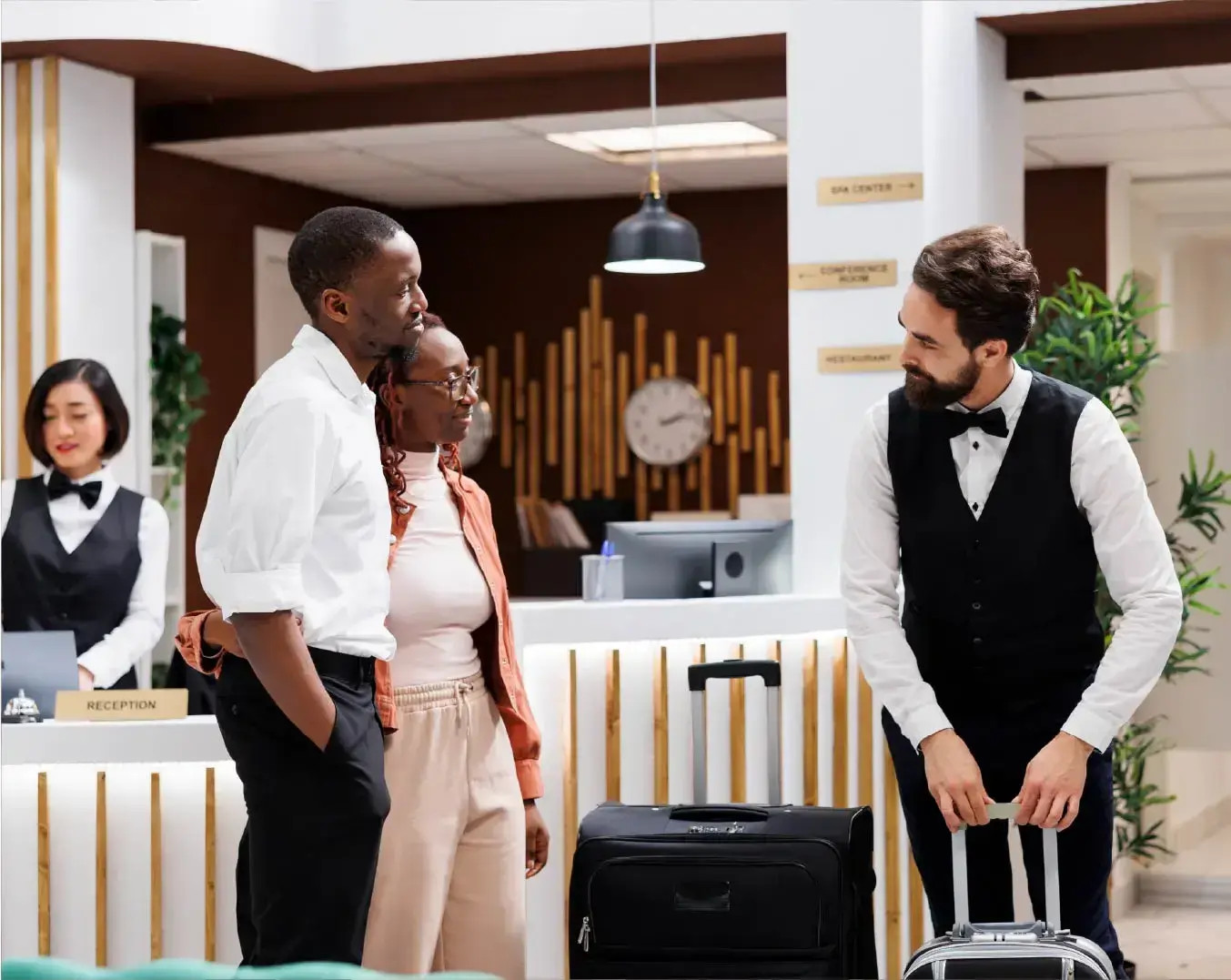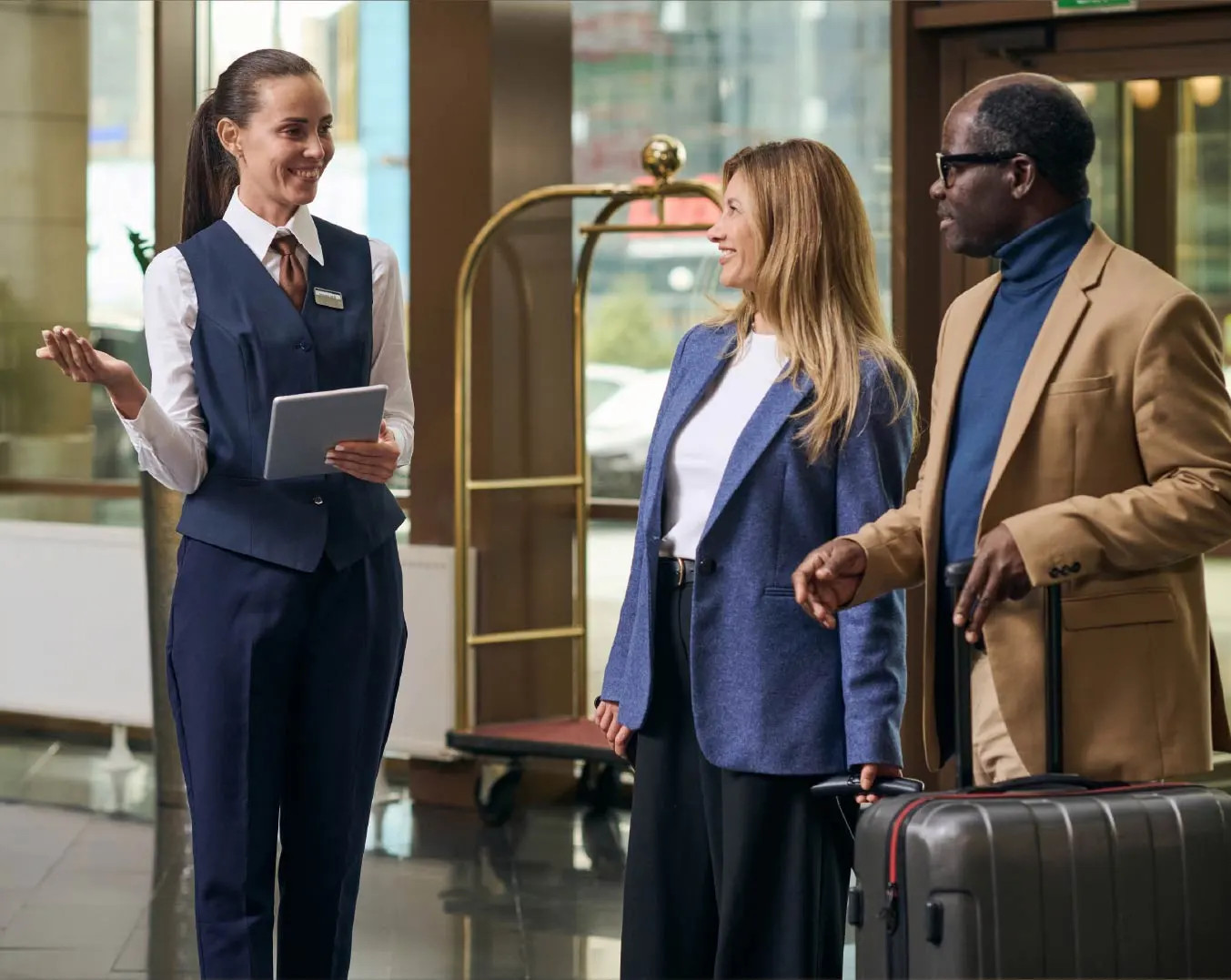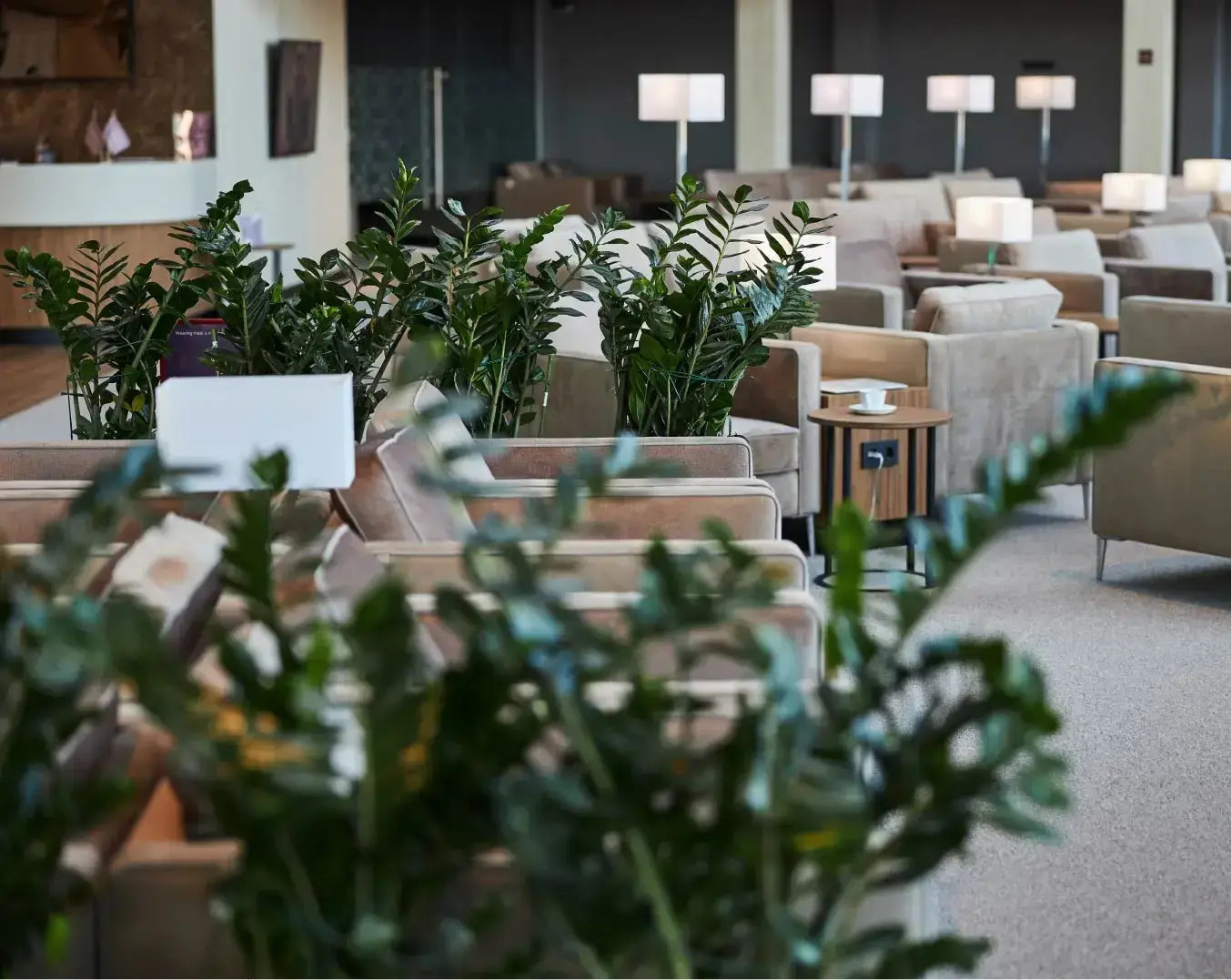First impressions are paramount in the hospitality industry, and the way your hotel staff greets guests sets the tone for their entire stay. Ensuring that your greetings are not only warm and welcoming but also grammatically correct and authentically delivered is crucial for creating a positive and professional atmosphere. This article delves into the best practices for greeting hotel guests, focusing on techniques that are both effective and reflect well on your establishment.
The Importance of Initial Contact
The initial greeting is more than just a formality; it’s the foundation of the guest experience. It’s the first opportunity to make guests feel valued, recognized, and comfortable. A well-executed welcome can immediately put guests at ease after their journey, whether it’s been a long flight or a short drive. Conversely, a lackluster or unprofessional greeting can create a negative first impression that’s difficult to overcome.
 practices for greeting guests
practices for greeting guests
Key Elements of an Exceptional Guest Greeting
To ensure your guest greetings are both grammatically sound and genuinely welcoming, consider these essential practices:
1. Establishing Immediate Eye Contact
Eye contact is a fundamental aspect of human connection. Upon a guest’s arrival, making direct eye contact, even momentarily, signals acknowledgement and recognition. If you are engaged with another task, a brief eye contact and a nod can communicate “I see you, and I will be with you shortly.” Maintaining eye contact throughout the greeting process further strengthens the connection and shows attentiveness.
2. Professional Appearance and Attire
The appearance of your staff directly reflects the hotel’s brand image. “Dress to impress” is not just a saying but a vital element of hospitality. Uniforms are an excellent way to ensure consistency and professionalism, allowing guests to easily identify staff members. Well-presented staff instill confidence and project an image of competence and reliability. Even in more informal hotel settings, clear name tags or identifiers are essential for guest recognition and approachability. When staff feel confident in their appearance, it translates into more assured and effective guest interactions.
 11 best ways of greeting guests in the perfect hotel welcome Website body Image 1 1076 x 1352-50
11 best ways of greeting guests in the perfect hotel welcome Website body Image 1 1076 x 1352-50
3. Engaging with Thoughtful Questions
Initiating conversation with guests through thoughtful questions is a powerful way to build rapport. While respecting privacy, asking about their journey or their plans during their stay demonstrates genuine interest and care. For instance, inquiring about their travel experience or expressing interest in their visit’s purpose can make guests feel more personally connected. This approach not only enhances the welcoming experience but also provides opportunities to offer relevant services, amenities, or local recommendations. Remember to listen attentively to their responses, showing that you value their input.
4. The Power of a Genuine Smile
A genuine smile is universally understood and incredibly impactful. It conveys warmth, friendliness, and approachability instantly. Greeting guests with a sincere smile after their travels can be incredibly refreshing and reassuring. It’s a simple yet highly effective way to break the ice and create a positive initial interaction. Ensure smiles are authentic and reach the eyes to maximize their positive effect.
5. Offering Proactive Assistance
Anticipate guest needs by proactively offering assistance. This could range from help with luggage to providing directions or information about the hotel facilities. Even if assistance is declined, the gesture itself is greatly appreciated and demonstrates a commitment to exceptional service. Offering help before being asked showcases attentiveness and a desire to go the extra mile for guest comfort.
6. Maintaining Cordiality Under Pressure
The hospitality environment can be demanding, and staff may often be busy. However, it’s crucial to maintain cordiality at all times. Even when occupied, acknowledge arriving guests with a warm greeting and an assurance that you will attend to them as soon as possible. Communicating honestly about wait times and remaining polite and professional, even when stressed, helps manage guest expectations and maintain a positive atmosphere.
7. Personalizing the Welcome Experience
Making guests feel special involves personalization. Reviewing booking information for special occasions like birthdays or anniversaries allows for personalized acknowledgements upon check-in. A simple “Happy Birthday” or “Welcome back for your anniversary” can significantly enhance the guest’s experience. Going further with small gestures like complimentary welcome drinks or room enhancements can create memorable and positive impressions.
8. Highlighting Hotel Amenities and Points of Interest
During the greeting process, inform guests about key hotel amenities and points of interest. Mentioning the restaurant, bar, pool, or other services available helps guests feel oriented and informed. This can be done subtly and informatively, without sounding overly sales-oriented. Providing this information upfront empowers guests to start enjoying the hotel facilities immediately and enhances their sense of belonging.
 11 best ways of greeting guests in the perfect hotel welcome Website body Image 2 1352 x 1076-50
11 best ways of greeting guests in the perfect hotel welcome Website body Image 2 1352 x 1076-50
9. Anticipating and Addressing Common Questions
Proactive service involves anticipating common guest queries and addressing them preemptively. New arrivals often have similar questions regarding breakfast times, Wi-Fi access, or local transportation. Providing this information upfront saves guests from having to ask and demonstrates preparedness and efficiency. Utilizing digital concierge services can further enhance this by providing guests with instant access to information and support.
10. Providing Realistic Wait Time Estimates
Transparency is key when there are wait times. If you are unable to attend to a guest immediately, provide an accurate estimate of how long they may need to wait. Honest communication manages expectations and allows guests to decide how to spend their waiting time, reducing frustration and demonstrating respect for their time.
11. Establishing Personal Connections
Finding common ground can create a more personal and memorable interaction. A genuine compliment on a guest’s attire or an observation about a shared interest (like a sports team logo on their clothing) can spark conversation and build rapport. These small moments of connection make guests feel seen and valued as individuals.
12. Offering a Refreshing Welcome Beverage or Treat
A thoughtful gesture like offering a welcome drink or a small treat upon arrival can make a significant positive impact. Whether it’s a glass of water, juice, or a small snack, this offering demonstrates hospitality and care, especially after travel. It’s a small investment that can create a lasting positive impression.
13. Acknowledging and Confirming Special Requests
Reviewing guest profiles for pre-arrival requests, such as room type preferences or accessibility needs, allows you to acknowledge these requests proactively during the greeting. Confirming that their requests have been noted and fulfilled saves guests from having to ask and reinforces that their needs are a priority.
14. Offering Local Insights and Tips
If time permits and guests are receptive, offering local tips and recommendations can greatly enhance their stay. This could include pointing out local attractions on a map, suggesting transportation options, or recommending local dining spots. Sharing insider knowledge shows care and adds value to their visit, making their experience more enjoyable and convenient.
15. Clearly Explaining Hotel Policies and Procedures
Transparency regarding hotel policies is essential for avoiding misunderstandings. Clearly explain any relevant procedures, such as security deposits or after-hours access protocols, during check-in. Addressing these points upfront minimizes potential issues and ensures a smoother stay for the guest.
16. Maintaining a Pristine Lobby and Reception Area
The lobby is the first physical space guests encounter, and its cleanliness and presentation are critical. Ensuring the lobby and reception areas are impeccably clean, well-maintained, and inviting creates a positive initial impression. Attention to details like fresh flowers, organized reception desks, and comfortable seating contributes to a welcoming ambiance.
 lobby-is-spick-and-span
lobby-is-spick-and-span
17. Leveraging Digital Tools for Efficiency
Employing digital tools like tablets or kiosks can streamline the check-in process and enhance efficiency. These technologies reduce wait times and administrative burdens, allowing staff to focus more on personalized guest interactions. Digital solutions can also facilitate personalized recommendations and services, further elevating the guest experience.
18. Demonstrating Cultural Sensitivity
In today’s diverse world, cultural sensitivity is paramount. While multilingualism is ideal, teaching staff basic greetings in multiple languages is a practical step towards making international guests feel more welcome. Being aware of cultural norms and avoiding potentially offensive gestures or assumptions is crucial for ensuring all guests feel respected and comfortable.
19. Providing Personalized Greetings for Returning Guests
Recognizing and acknowledging returning guests by name is a powerful way to build loyalty. Referencing past stays or remembered preferences demonstrates attention to detail and appreciation for their continued business. This level of personalization strengthens guest relationships and fosters long-term loyalty.
20. Projecting Professional and Appropriate Body Language
Staff body language plays a significant role in conveying professionalism and approachability. Maintaining an upright posture, using natural and open hand gestures, and projecting enthusiasm through body language reinforces a welcoming and competent image. Consistent positive body language, regardless of how busy staff are, is crucial for creating a positive guest perception.
Mews and Enhancing Your Guest Welcome Process
Mews offers solutions designed to streamline and personalize the guest welcoming process. Guest profiles within Mews provide valuable insights into guest preferences and past interactions, enabling staff to personalize greetings and tailor services from the moment of arrival. Mews’ online check-in capabilities free up front desk staff from administrative tasks, allowing them to focus on delivering exceptional, personalized welcomes and creating memorable first impressions.
Conclusion: Making Every Greeting Count
The initial guest greeting is a pivotal moment that significantly impacts the overall hotel experience. By focusing on delivering greetings that are not only grammatically correct and professionally executed but also genuinely warm and personalized, hotels can create lasting positive impressions. From establishing eye contact and offering sincere smiles to providing proactive assistance and leveraging technology, each element of the greeting process contributes to guest satisfaction and loyalty. Remember, greeting guests like it matters is not just a best practice; it’s an investment in your hotel’s reputation and long-term success. Mastering this art of welcome is essential for providing a truly top-notch hotel experience and ensuring guests feel valued from the very first interaction.

